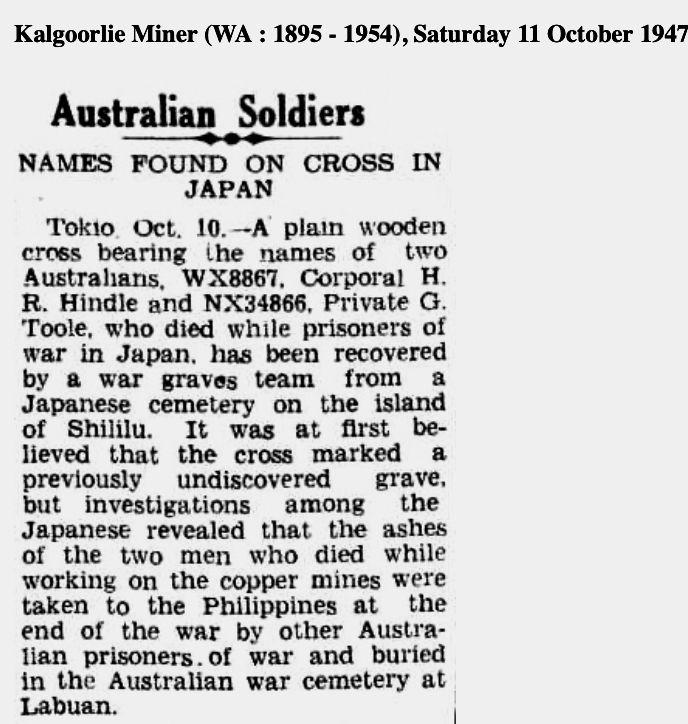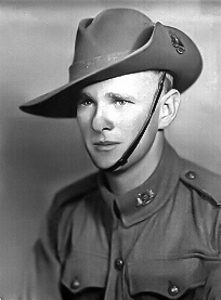Dick Hindle had survived action in Singapore, working at the Hellfire Pass region on the Burma-Thai Railway, a 70 day sea voyage on the Hellship ‘Rashin Maru from Singapore to Moji, Japan through a typhoon and US submarines. Please read further about ‘Rashin’ Maru known to the men who sailed in her as ‘Byoki’ Maru
Working below ground at the Sumitomo owned Besshi copper mine at Yamane, Shikoku Island Japan on 30 Sept 1944 there was a sudden rock fall which killed West Australian POW WX8869 Dick Hindle, 40 years of age and father to four children Dick was formerly a healthy man who had played competitive rugby until at least 1938.
Dick’s leg had been severed by the rock fall, from which he would have quickly bled to death. The tunnels the POWs slaved in were very small, no room for a man to stand or manouvre, especially the tall Australians. Originally these tunnels were constructed for Japanese workers to crawl through. Conditions would have been unimaginable and it would have been impossible for Dick to be saved. (Japanese records state ‘contusion of the head’).
Unfortunately we have no first hand descriptions of Dick’s death.
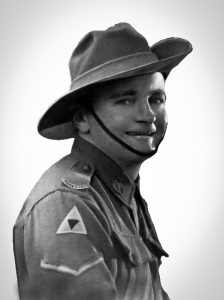
Prior to enlisting Dick was store foreman at Foggit Jones P/L in High Street Fremantle, a well-known cold meats and dairy (bacon, hams and cheeses) manufacturers and wholesalers with outlets across Australia. He was an outgoing and well liked young Australian.
He was born Herbert Roy Hindle 1916 at Pindar, about 30 km east of Mullewa to William Lawrence Hindle and Bridget Emily Danks who married at Mount Margaret 1895. There were six children.
When their youngest child was 12 months old, Lawrence William Hindle enlisted in WW1 with 11th Battalion. He was tragically killed in action at Pozieres, France 23 July 1916 during the Battle of the Somme. Dick was then 12 years old.
Below: Lawrence William Hindle who died France 23 July 1916.
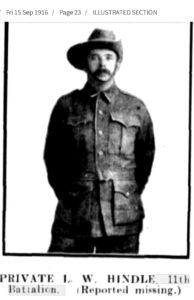
Please read about other 2/4th boys with 11th Battalion connections
Dick married in 1927 at Fremantle to Phyllis May Harris. Phyllis is sister to another 2/4th soldier WX4987 Norman Joseph Harris who enlisted AIF 23 Jul 1940 and later joined ‘B’ Coy, 9 Platoon becoming Platoon Sergeant 24 Jan 1942.
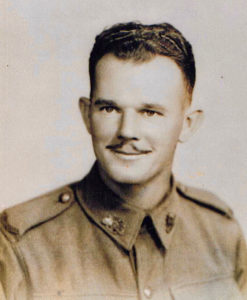
Norm Harris had been sent to Japan with ‘J’ Force and was a POW working at Kobe. The two men would not have known of the other’s location. Harris was returned to Australia at the end of the war.
The POWs who arrived on ‘Rashin’ Maru were already in poor physical condition having spent 70 days mostly in the hull of the ship, receiving minimal food and unable to move about freely, living in crowded and filthy conditions with many sick and some dying.
Please read the below Medical Classification.
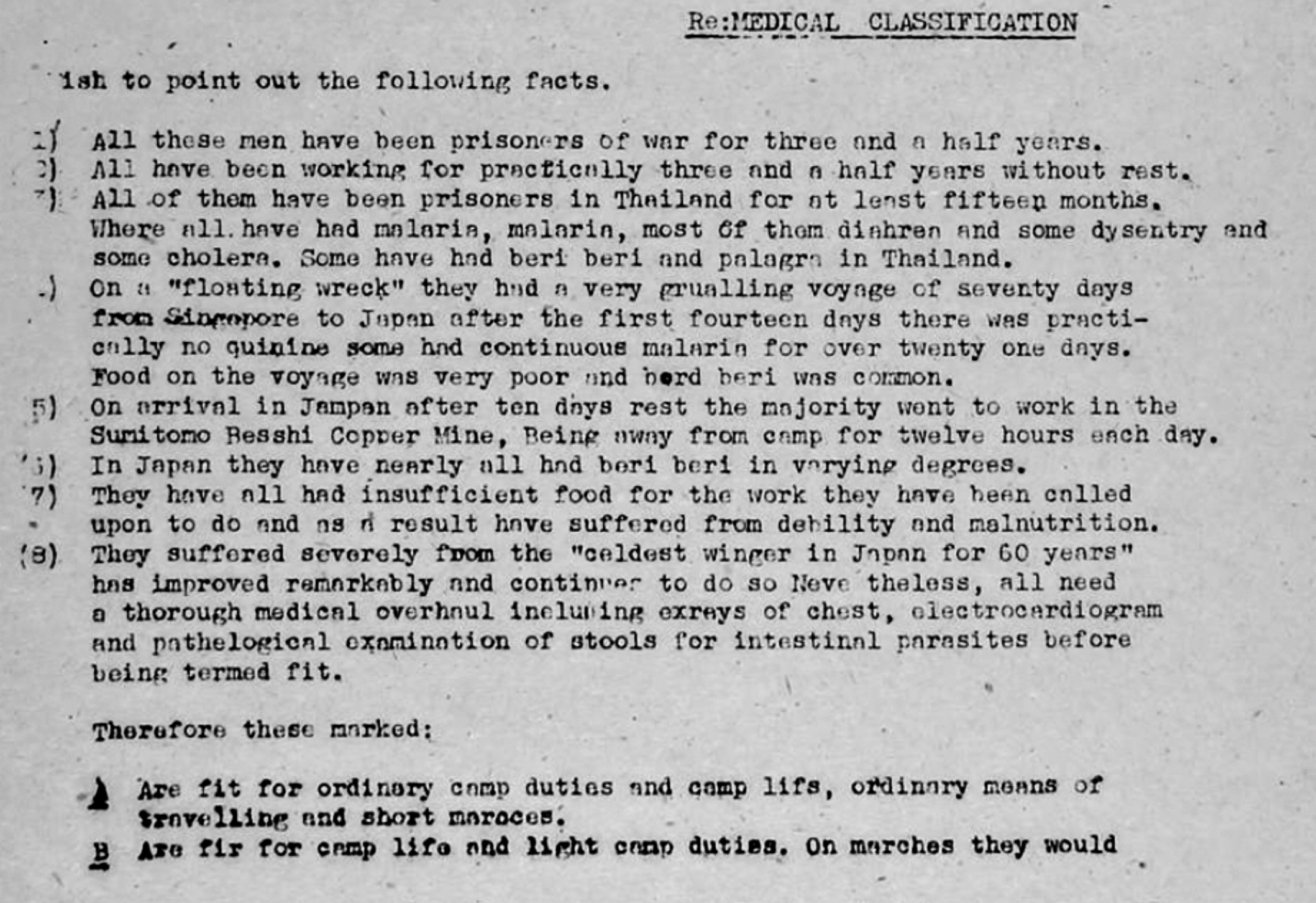
The prisoners were bought to this location to work below and above ground at the Sumitomo Besshi copper mine. The mine was located in the Besshi Mountain at an elevation 2,000 feet above sea level, approximately 7 and a half miles to the south of, and overlooking the Port of Niihama. Two mine shafts extended eastward from their entrances for 5 miles into the hills. The mine was not only rich in copper but also gold and bauxite, used in the manufacture of aircraft.
The mine kept 100,000 people gainfully employed and there is no doubting that Niihama’s industry that encompassed an area of 12 and a half miles only existed because of the mine. The copper, aluminium and chemical refineries and foundry of the Yamane-Niihama area were an important contributor towards Japan’s war effort. The copper, bauxite and gold ore was taken from the mine in railway ore cars to the wharf between machinery and chemical plants where it was shipped to Shikan Island for refining. The ores, once refined, were shipped back to the foundry, machinery, chemical and aluminium plants at Niihama.
On 11th September,1944 the POWs began working at the mine. There had been no time or reason why the men’s health would have improved since arrival – rations and rest had not been increased.
Their first, and presumably, a typical day at the Besshi copper mine was as follows:
After breakfast they were marched to the Niihama Railway Station where they were unceremoniously piled into open railway ore trucks for the trip up the mountain – how they must have felt the cold! On arrival at the mine the men were paraded outside the mine offices and introduced to Capt Takuji Marukami. In a display of swordmanship before a captive POW audience he convinced all who were paraded before him that they must work hard to mine the copper ore for Japan or he would have their heads. Capt Marukami, from this time forth earned himself the nickname of “lolly lopper” attributed to his impressive demonstration of swordsmanship.
Capt Marukami at War Trials.
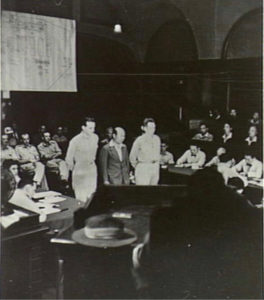
Most, but not all the men, were to work below ground. Some of the machine gunners were to work above ground on mine maintenance and repair duties. Jim Elliott WX8619 and Edwin Adams WX8245 worked in the carpentry shop and Claude Dow WX17591 worked as a drill sharpener. There were many 2/4th Machine Gun Battalion Members working below ground in Japan, however this mine would take its toll upon this battalion.
The first casualty from the 2/4th at Yamane was Roy “Dickie” Hindle. Roy died on 30th September 1944 as a result of an underground rock fall – not yet three weeks since the men began working at Sumitomo’s Yamane copper mine. Roy’s body was cremated and his ashes were carried by an Australian officer to Manila. From there they were forwarded onto Labuan War Cemetery for burial.

Another casualty, although not fatal, was that of Arch “Strawb” Dyson WX7599 who in January 1945 was pinned between a copper ore truck and a wall injuring both his legs. Tom Wayman WX75902 was another who suffered injury. Working below ground repairing iron water pipes that had corroded through. Tom’s hand was crushed causing severe nerve damage.
Below: Tom Wayman
Bert Norton WX8493 (above) was pinned by leg under a rock during a cave in. He bore a large scar on his leg and smaller scars on his back to remind him long after the war. He was taken to Gulian Hospital by mine fire engine , cleaned and stitched then to camp with several weeks off work. Then back to mine on light duties for a few days before going back down the shaft.
On 18th May 1945 the prisoners were moved from work at the Besshi copper mine throughout Japan’s winter to the wharves, smelters and refineries of Niihama.
The reason for this move was simply because the men’s health had flagged so much that they were of no further use to the Japanese at the mine site.
